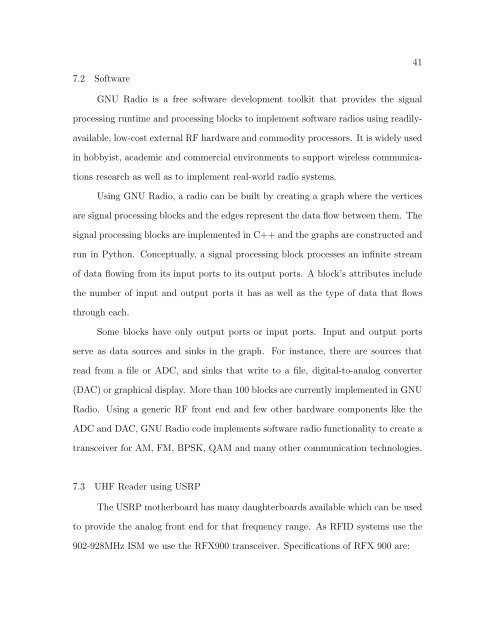utilizing physical layer information to improve rfid tag
utilizing physical layer information to improve rfid tag
utilizing physical layer information to improve rfid tag
Create successful ePaper yourself
Turn your PDF publications into a flip-book with our unique Google optimized e-Paper software.
7.2 Software<br />
GNU Radio is a free software development <strong>to</strong>olkit that provides the signal<br />
processing runtime and processing blocks <strong>to</strong> implement software radios using readily-<br />
available, low-cost external RF hardware and commodity processors. It is widely used<br />
in hobbyist, academic and commercial environments <strong>to</strong> support wireless communica-<br />
tions research as well as <strong>to</strong> implement real-world radio systems.<br />
Using GNU Radio, a radio can be built by creating a graph where the vertices<br />
are signal processing blocks and the edges represent the data flow between them. The<br />
signal processing blocks are implemented in C++ and the graphs are constructed and<br />
run in Python. Conceptually, a signal processing block processes an infinite stream<br />
of data flowing from its input ports <strong>to</strong> its output ports. A block’s attributes include<br />
the number of input and output ports it has as well as the type of data that flows<br />
through each.<br />
Some blocks have only output ports or input ports. Input and output ports<br />
serve as data sources and sinks in the graph. For instance, there are sources that<br />
read from a file or ADC, and sinks that write <strong>to</strong> a file, digital-<strong>to</strong>-analog converter<br />
(DAC) or graphical display. More than 100 blocks are currently implemented in GNU<br />
Radio. Using a generic RF front end and few other hardware components like the<br />
ADC and DAC, GNU Radio code implements software radio functionality <strong>to</strong> create a<br />
transceiver for AM, FM, BPSK, QAM and many other communication technologies.<br />
7.3 UHF Reader using USRP<br />
The USRP motherboard has many daughterboards available which can be used<br />
<strong>to</strong> provide the analog front end for that frequency range. As RFID systems use the<br />
902-928MHz ISM we use the RFX900 transceiver. Specifications of RFX 900 are:<br />
41
















